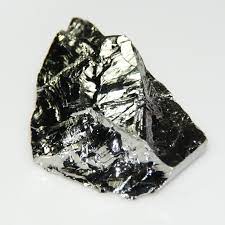Properties:
Germanium is a chemical element with atomic number 32. It is shiny, light gray, metal. Germanium is hard and its pure form is semiconductor. It is rarely found in high concentration, which is why Ge was discovered very late. Germanium is not a vital element for any living organism. Natural germanium is somewhat insoluble in water and almost nontoxic.
Germanium resembles a metal. It has splendid, gleaming, shiny shading. In any case, it is brittle and breaks easily, which metals actually don't do. It has a melting of 937.4°C and boiling point of 2,830°C. It conducts an electric current inadequately. Substances of this kind are semiconductors. Germanium conducts an electric current, yet not as well as metals like silver, copper, and aluminum. The capability of semiconductors to conduct electricity depends on the presence of little amount of impurities. For Germanium to effectively conduct electricity the impurity is added. The process is called doping. Germanium is a moderately inactive element. It doesn't break down in water and does not react with oxygen at room temperature. It dissolves in hot acids and with oxygen at high temperatures. It turns out to be more dynamic when finely partitioned. It will mix with chlorine and bromine to form germanium chloride and germanium bromide.

Applications:
Germanium first served in applications as a semiconductor but lately it found many other uses in industries.
- Almost half of amount of Germanium is used to manufacture fiber optic systems.
- Germanium is used in wide angle camera lenses and objective lenses for microscopes.
- Germanium is utilized to produce fluorescent lamps.
- Germanium serves as a catalyst.
- Germanium is used in infrared spectroscopes.
- Germanium is also used to make specialized glass for military applications.
- Germanium is used in satellite systems and fire alarm systems.
For related products please visit:
Comments
Post a Comment